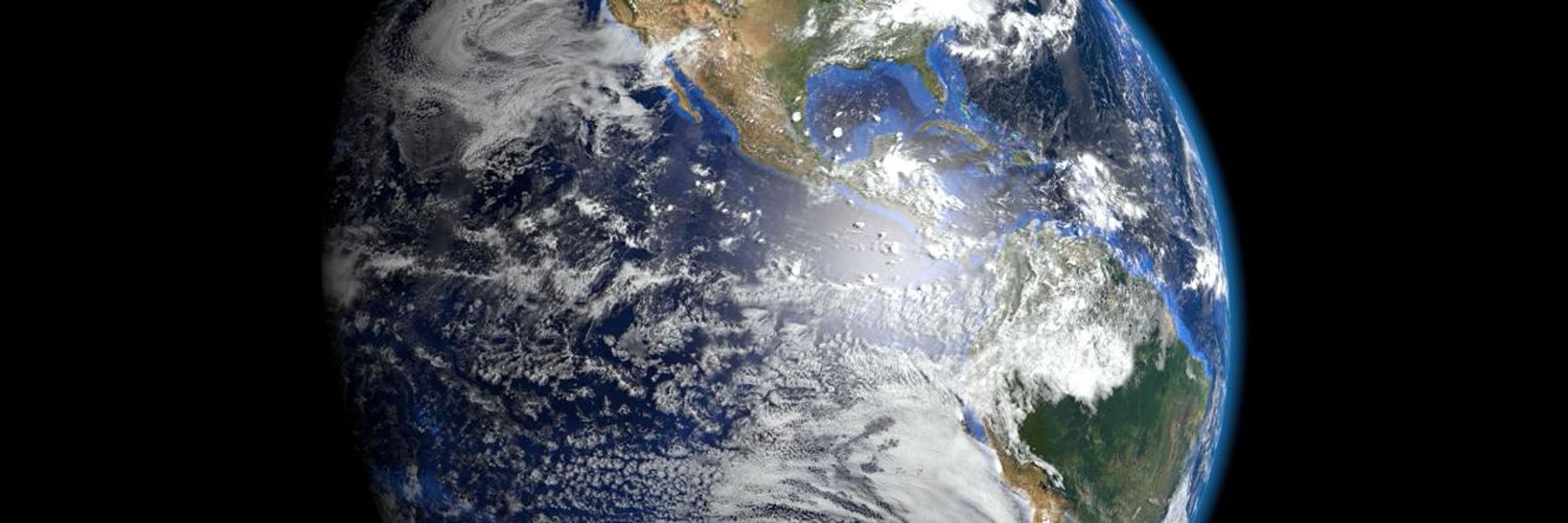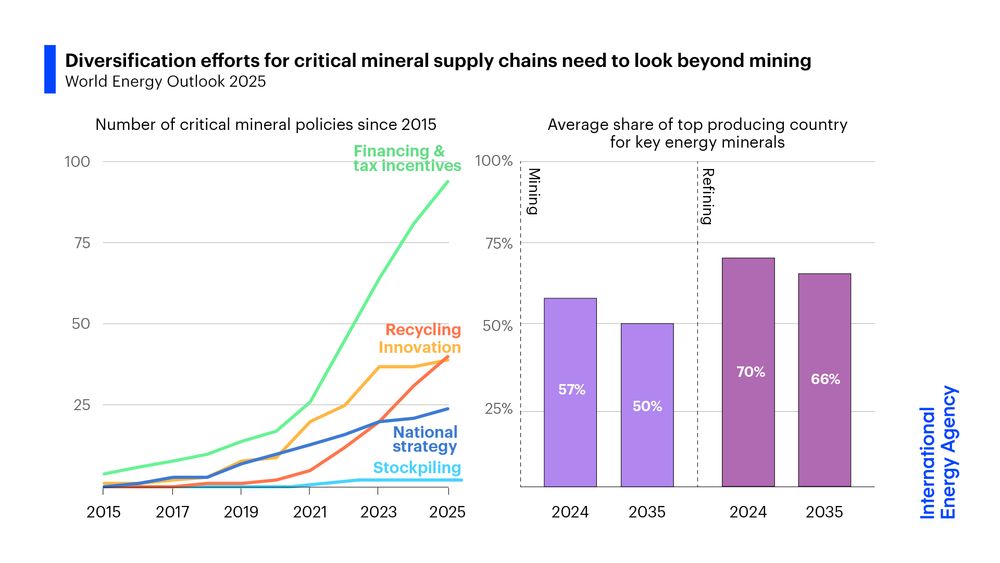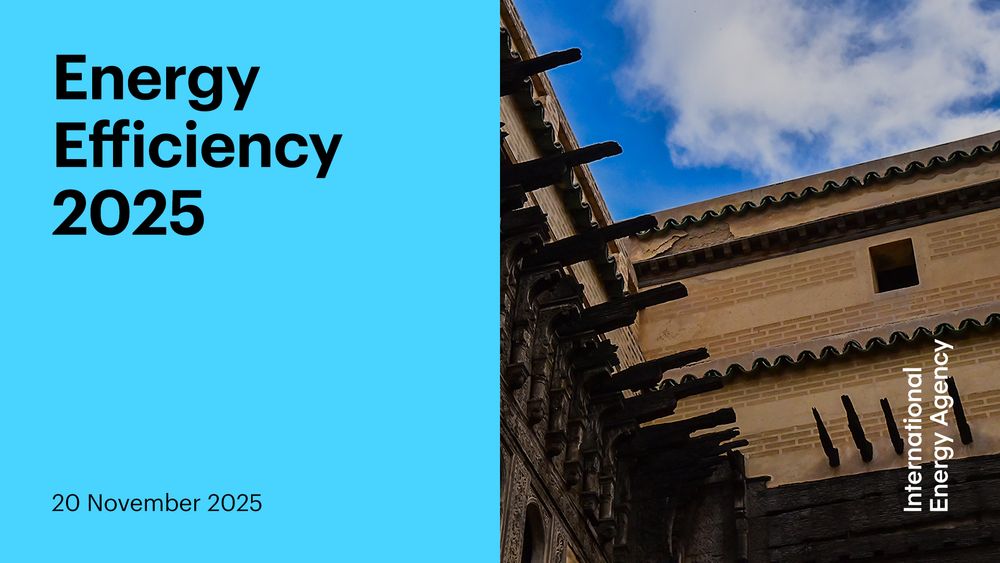
Our new report looks at how targeted policies can support wholesale markets & address common challenges across different regions.
Read more 👉 iea.li/4ohdWUs

Our new report looks at how targeted policies can support wholesale markets & address common challenges across different regions.
Read more 👉 iea.li/4ohdWUs
Stronger efforts are also needed to diversify refining & processing 👉 iea.li/47FZC2V

Stronger efforts are also needed to diversify refining & processing 👉 iea.li/47FZC2V
Electricity is the key energy source for sectors accounting over 40% of the global economy & the main energy source for most households 👉 iea.li/4oyh2UX

Electricity is the key energy source for sectors accounting over 40% of the global economy & the main energy source for most households 👉 iea.li/4oyh2UX
Current Policies Scenario: iea.li/3LsCCf9
Stated Policies Scenario: iea.li/4payXBg
Implications: iea.li/4p5dwRO
ACCESS Scenario: iea.li/4oyWUC2
Net Zero Emissions by 2050: iea.li/47Bl3SF

Current Policies Scenario: iea.li/3LsCCf9
Stated Policies Scenario: iea.li/4payXBg
Implications: iea.li/4p5dwRO
ACCESS Scenario: iea.li/4oyWUC2
Net Zero Emissions by 2050: iea.li/47Bl3SF
In the Current Policies Scenario, demand keeps rising to 2035 & beyond as EV sales stall outside China & Europe
In the Stated Policies Scenario, EV growth flattens global oil use around 2030: iea.li/4oyh2UX

In the Current Policies Scenario, demand keeps rising to 2035 & beyond as EV sales stall outside China & Europe
In the Stated Policies Scenario, EV growth flattens global oil use around 2030: iea.li/4oyh2UX
In very hot years, peak temperatures could boost electricity demand by 260 GW, while derating – when heat forces power plants below full output – could cut capacity further: iea.li/4p5dwRO

In very hot years, peak temperatures could boost electricity demand by 260 GW, while derating – when heat forces power plants below full output – could cut capacity further: iea.li/4p5dwRO
On Wednesday, we’ll publish a report on adapting market designs to evolving needs as power systems undergo rapid changes.
Learn more 👉 iea.li/3LQkIDh

On Wednesday, we’ll publish a report on adapting market designs to evolving needs as power systems undergo rapid changes.
Learn more 👉 iea.li/3LQkIDh
Subscribe 👉 iea.li/46hK4QL
Read it here 👉 iea.li/4oi53tD

Subscribe 👉 iea.li/46hK4QL
Read it here 👉 iea.li/4oi53tD
Achieving universal access would create over 460,000 jobs by 2040 – with most requiring minimal training 👉 iea.li/47qlGOZ

Achieving universal access would create over 460,000 jobs by 2040 – with most requiring minimal training 👉 iea.li/47qlGOZ
It explores 🇧🇷’s unique opportunity to build on its energy strengths & reinforce its role as a global energy leader.
Learn more 👉 iea.li/3WQhT7p

It explores 🇧🇷’s unique opportunity to build on its energy strengths & reinforce its role as a global energy leader.
Learn more 👉 iea.li/3WQhT7p
New projects are emerging worldwide, but planned refining & magnet manufacturing capacity outside of China remains well below that for mining 👉 iea.li/4nn4mim

New projects are emerging worldwide, but planned refining & magnet manufacturing capacity outside of China remains well below that for mining 👉 iea.li/4nn4mim
Drawing on insights from our recent report, experts will explore how to mobilise the investment needed to achieve universal access across the continent.
Register now 👉 iea.li/3KiE4Al

Drawing on insights from our recent report, experts will explore how to mobilise the investment needed to achieve universal access across the continent.
Register now 👉 iea.li/3KiE4Al
Since 2010, new capacity for low-emissions power generation has surged, led by solar & wind
Since 2020, EV sales have taken off – especially in China, where about half of new cars sold are electric: iea.li/43rqYXX

Since 2010, new capacity for low-emissions power generation has surged, led by solar & wind
Since 2020, EV sales have taken off – especially in China, where about half of new cars sold are electric: iea.li/43rqYXX
In the coming years, other emerging economies, led by India & Southeast Asia, are set to become increasingly influential in growth trends 👉 iea.li/4a7Yjv5

In the coming years, other emerging economies, led by India & Southeast Asia, are set to become increasingly influential in growth trends 👉 iea.li/4a7Yjv5
It would prevent 4.7 million premature deaths, free up time for women & children, create nearly half a million jobs & cut emissions by around 550 million tonnes 👉 iea.li/4nW9z1Y

It would prevent 4.7 million premature deaths, free up time for women & children, create nearly half a million jobs & cut emissions by around 550 million tonnes 👉 iea.li/4nW9z1Y
It explores how strong planning & policies can help 🇨🇿 unlock significant economic opportunities as it works towards reaching its energy goals.
Learn more 👉 iea.li/3LT3THE

It explores how strong planning & policies can help 🇨🇿 unlock significant economic opportunities as it works towards reaching its energy goals.
Learn more 👉 iea.li/3LT3THE
While new capacity is expanding in battery production, progress remains limited in vulnerable midstream segments like cathode precursors, anode material & refined metals 👉 iea.li/4nn4mim

While new capacity is expanding in battery production, progress remains limited in vulnerable midstream segments like cathode precursors, anode material & refined metals 👉 iea.li/4nn4mim
In the Current Policies Scenario, demand keeps rising to 2035 & beyond as EV sales stall outside China & Europe
In the Stated Policies Scenario, EV growth flattens global oil use around 2030: iea.li/4oyh2UX

In the Current Policies Scenario, demand keeps rising to 2035 & beyond as EV sales stall outside China & Europe
In the Stated Policies Scenario, EV growth flattens global oil use around 2030: iea.li/4oyh2UX
And nuclear’s comeback is underway, with global capacity set to rise by at least a third by 2035
Natural gas' role in power systems is also set to grow ➡️ iea.li/4oyh2UX

And nuclear’s comeback is underway, with global capacity set to rise by at least a third by 2035
Natural gas' role in power systems is also set to grow ➡️ iea.li/4oyh2UX
In 2024, China accounted for 60% of global mining output for rare earths used in magnets – and more than 90% of refining & magnet manufacturing.
More 👉 iea.li/4nn4mim

In 2024, China accounted for 60% of global mining output for rare earths used in magnets – and more than 90% of refining & magnet manufacturing.
More 👉 iea.li/4nn4mim
It shows global efficiency progress is set to accelerate this year, improving 1.8% compared with just 1% in 2024.
This renewed momentum is key for efforts to boost energy security & economic competitiveness.
Read more 👉 iea.li/4pi0dh5

It shows global efficiency progress is set to accelerate this year, improving 1.8% compared with just 1% in 2024.
This renewed momentum is key for efforts to boost energy security & economic competitiveness.
Read more 👉 iea.li/4pi0dh5
It examines the latest efficiency trends around the globe & the implications for energy security, affordability, economic competitiveness & emissions.
Join our experts as they discuss the key findings 👉 iea.li/4oKRd47

It examines the latest efficiency trends around the globe & the implications for energy security, affordability, economic competitiveness & emissions.
Join our experts as they discuss the key findings 👉 iea.li/4oKRd47
Current Policies Scenario: iea.li/3LsCCf9
Stated Policies Scenario: iea.li/4payXBg
Implications: iea.li/4p5dwRO
ACCESS Scenario: iea.li/4oyWUC2
Net Zero Emissions by 2050: iea.li/47Bl3SF

Current Policies Scenario: iea.li/3LsCCf9
Stated Policies Scenario: iea.li/4payXBg
Implications: iea.li/4p5dwRO
ACCESS Scenario: iea.li/4oyWUC2
Net Zero Emissions by 2050: iea.li/47Bl3SF
Electricity is the key energy source for sectors accounting over 40% of the global economy & the main energy source for most households 👉 iea.li/4oyh2UX

Electricity is the key energy source for sectors accounting over 40% of the global economy & the main energy source for most households 👉 iea.li/4oyh2UX
About 300 billion cubic metres of new annual LNG export capacity is scheduled to start operation by 2030
But questions remain about where all the new LNG will go 👉 iea.li/3Xy4QHO

About 300 billion cubic metres of new annual LNG export capacity is scheduled to start operation by 2030
But questions remain about where all the new LNG will go 👉 iea.li/3Xy4QHO

